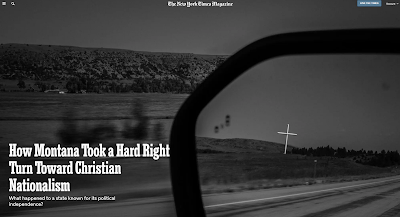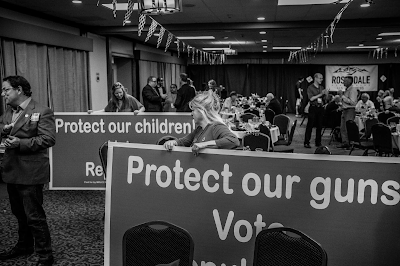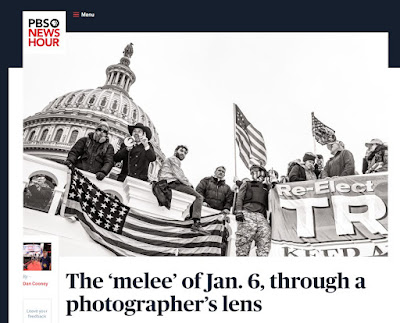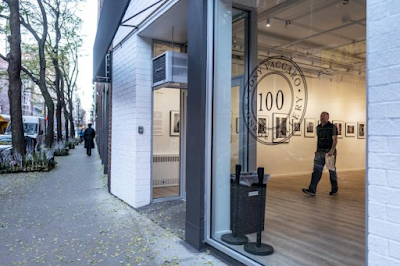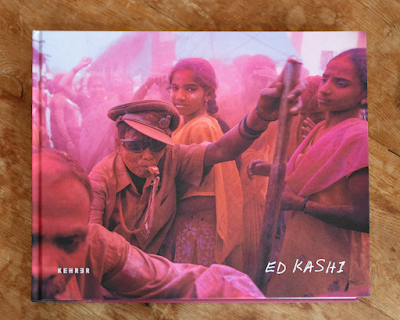January 30, 2023
Tuesday, January 31, 2023
Bill Eppridge's Photograph in the NY Times Obituary for Bobby Hull
Sunday, January 29, 2023
David Butow Photographs Star Ballroom Shooting Memorials and Resilience for CNN
Via CNN
January 29, 2023
By Elizabeth Wolfe, CNN. Photographs by David Butow
After tragedy struck Monterey Park’s vibrant dance community, residents insist they will return to their beloved ballroom --click for full article.
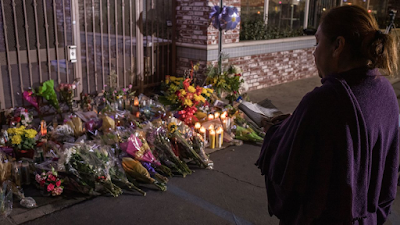
The gates outside the Star Ballroom Dance Studio have become surrounded by a makeshift memorial.
Thursday, January 26, 2023
A show celebrating acclaimed photographer Tony Vaccaro at Santa Fe’s Monroe Gallery of Photography (112 Don Gaspar) can be viewed for five more days—through Jan. 29
January 25, 2023
Honoring Vaccaro
Speaking of countdowns, a show celebrating acclaimed photographer Tony Vaccaro at Santa Fe’s Monroe Gallery of Photography (112 Don Gaspar) can be viewed for five more days—through Jan. 29. Monroe mounted two exhibitions—here and a New York pop-up last month—to honor Vaccaro’s 100th birthday; the photographer died on Dec. 28, just eight days after his centennial, which he celebrated in New York with friends at a surprise birthday dinner.
A New York Times obituary recounts how Vaccaro became a war photographer in World War II—also the subject of a 2016 HBO documentary. After the war, he transitioned and began to make fashion, travel and celebrity photographs for the country’s leading magazines.
Those celebrities included Georgia O’Keeffe, whom Life magazine assigned Vaccaro to photograph in 1960. O’Keeffe expected a more famous photographer and at first refused to pose: “To win her over, Mr. Vaccaro cooked a meal and made a picnic lunch. When the weather turned too windy for the picnic, he gave her a plate of Swiss cheese as she sat in the back of his car. And when she playfully peered through a hole in a piece of the cheese, Mr. Vaccaro went into action,” the obituary reads. His other famous subjects included John F. Kennedy, Pablo Picasso and Sophie Loren, to name a few.
This quote from Vaccaro accompanies Monroe’s information on the exhibition: “We call each other German, French, Italian. There is no Italian blood. There is no French blood. It’s human blood. On this Earth there is one humanity. Let’s do something about it. Let’s live! In a way, photography was my way of telling the world, ‘We have better things to do than to kill ourselves.’”
Saturday, January 14, 2023
Ashley Gilbertson Photographs in January 15, 2023 NY Times
January 14, 2023
How Montana Took a Hard Right Turn Toward Christian Nationalism
What happened to a state known for its political independence?
Photographs by Ashley Gilbertson for The New York Times
Ashley Gilbertson is an Australian photographer and writer living in New York. His photograph from the Jan. 6 attack was part of the Times entry that was a finalist in the breaking-news-reporting category of the Pulitzer Prizes in 2022.
Tuesday, January 10, 2023
Poor People’s Art: A (Short) Visual History of Poverty in the United States; Artist's talk with Nina Berman January 12
January 13 – March 4, 2023
University of South Florida Contemporary Art Museum
Nina Berman: John Bonner and Richard Huntly, from the series The Black Boys of Dozier, 2013
Thousands of boys, mainly black, passed through Dozier since it opened in 1901 as a reform school for wayward boys. But allegations over the years suggest it functioned more like a slave labor camp, with verified reports of children being hog tied and shackled. The name of the institution changed as each successive administration installed its own brand of punishment and forced labor, finally closing in 2011, not because of allegations, but according to the State, because of budget issues.Panel discussion Thursday, January 12 with artists featured in Poor People’s Art: A (Short) Visual History of Poverty in the United States, including Nina Berman, Rico Gatson, and Jason Lazarus. Curator Christian Viveros-Fauné will lead the conversation exploring issues and topics addressed in the exhibition. This event is free and open to the public, Facebook live link here.
Dr. Martin Luther King Jr. is well known for his “I Have a Dream” speech, yet much less emphasis is placed on his campaign to seek justice for America’s poor, “The Poor People’s Campaign.” This was a multi-cultural, multi-faith, multi-racial movement aimed at uniting poor people and their allies to demand an end to poverty and inequality. Fifty-three years after Dr. King’s death, the Reverend William Barber II launched a contemporary push to fulfill MLK’s ambitious brief — one that calls for a “revolution of values” that unites poor and impacted communities across the country. The exhibition Poor People’s Art: A (Short) Visual History of Poverty in the United States represents a visual response to Dr. King’s “last great dream” as well as Reverend Barber’s recent “National Call for Moral Revival.”
With artworks spanning more than 50 years, the exhibition is divided into two parts: Resurrection (1968-1994) and Revival (1995-2022). Resurrection includes photographs, paintings, prints, videos, sculptures, books, and ephemera made by a radically inclusive company of American artists, from Jill Freedman's photographs of Resurrection City, the tent enclave that King's followers erected on the National Mall in 1968, to John Ahearns' plaster cast sculpture Luis Fuentes, South Bronx (1979). Revival offers contemporary engagement across a range of approaches, materials, and points of view. Conceived in a declared opposition to poverty, racism, militarism, environmental destruction, health inequities, and other interlocking injustices, this exhibition shows how artists in the US have visualized poverty and its myriad knock-on effects since 1968. Participating artists include John Ahearn, Nina Berman, Martha De la Cruz, Jill Freedman, Rico Gatson, Mark Thomas Gibson, Corita Kent, Jason Lazarus, Miguel Luciano, Hiram Maristany, Narsiso Martinez, Adrian Piper, Robert Rauschenberg, Rodrigo Valenzuela, William Villalongo & Shraddha Ramani.
Poor People’s Art is curated by Christian Viveros-Fauné, CAM Curator-at-Large and organized by the USF Contemporary Art Museum. Exhibition Press Release
Monday, January 9, 2023
War-scarred land: Nina Berman and Ashley Gilbertson featured in award-winning book depicting collateral damage of U.S. military at home
Below, the Richard L. Menschel Curator of Photography at the Harvard Art Museums walks us through a few of the images she selected. (Full post here)
A Housing Development Bordering the Starmet Superfund Site, Concord, Mass., USA” (July 3, 2016) by Nina Berman, American (b. New York, N.Y. 1960). © Nina Berman; image courtesy of Nina Berman
Just outside Walden Pond, a toxic dump
Nina Berman’s photograph was made in nearby Concord. Made at sites across the country, Berman’s series “Acknowledgment of Danger” takes its title from a waiver visitors must sign before entering the toxic grounds of a former military facility. In Concord, she photographed a new housing development in early morning light. Concord is known for its connections to the Revolutionary War and to the U.S. environmental movement. (The pictured site is six miles from Walden Pond, made famous by Henry David Thoreau’s 19th-century nature writing.) Here, Berman draws out this site’s link to modern warfare: Starmet Corp. (formerly Nuclear Metals Inc.) manufactured products from depleted uranium, primarily for armor-piercing ammunition, among other things. The company discharged toxic waste into an unlined holding basin for nearly 30 years, contaminating the soil and groundwater. In 2001, the facility was placed on the National Priorities List, an EPA registry of the nation’s most hazardous sites.
“A Resident Talks to Workers in the Hunter’s Point Neighborhood of San Francisco, Calif., on May 5, 2017.” From the series “Bombs in Our Backyard” by Ashley Gilbertson, Australian (b. Melbourne 1978). © Ashley Gilbertson/VII; image courtesy of the artist
Story of environmental racism
It was important to me that the exhibition speak to the fact that communities of color are disproportionately impacted by this pollution and toxicity. Ashley Gilbertson made this photograph in a neighborhood in my hometown of San Francisco, called Hunter’s Point. The neighborhood was largely built on a former naval base, today a Superfund site. Growing up, I knew kids who lived here — heard them talk about their eczema and asthma. In 2017-18, Gilbertson, a contributor to the catalog, acclaimed for his photographs of conflict in the Middle East, turned his attention to the U.S., documenting pollution caused by the military for the investigative journalism nonprofit ProPublica. Gilbertson collaborated with journalist Abrahm Lustgarten (another contributor to the catalog) to produce a series of in-depth reports on the pollution from former chemical weapons test sites and the harmful ways the military has chosen to dispose of chemicals and munitions. In his larger series, Gilbertson shows how people and toxins intersect — from illness to activism to labor and daily life in a poisonous environment.
*
Saturday, January 7, 2023
Gallery Photographer Nate Gowdy Interviewed on PBS New Hour for Anniversary of January 6 Insurrection
January 6, 2023
On Jan. 6, 2021, photographer Nate Gowdy was at the U.S. Capitol on assignment for Rolling Stone when what was billed as a pro-Trump rally escalated into an insurrection. He was on his way to take photos of the rally at the Ellipse when groups of people started walking toward the Capitol.
Hours later, Gowdy writes in his new book, he was “caught in a melee of war cries, adrenaline and suddenly surging bodies.”
After covering the mayhem outside the Capitol, Gowdy faced his own chaotic situation days later. His camera and computer with his Jan. 6 images were stolen from Washington’s Union Station.
“I would have sacrificed an arm or a leg to get those photos back,” he said.
Beyond capturing a shocking chapter in American political history, the images were also meant to be the conclusion to a book he had been long working on.
As friends tried to console him and help him replace his equipment, one acquaintance had a lucky, one-in-a-million break, spotting his original gear for sale online, and eventually reuniting him with his images.
“Insurrection,” a recent collection of 124 of Gowdy’s photos, offers a timeline of the day’s events through vivid portraits of the Trump supporters who broke into the complex while Congress counted Electoral College votes to confirm President Joe Biden’s 2020 election victory.
More than 950 people have been arrested for participating in the Capitol insurrection, the Justice Department reported Wednesday — two days ahead of the attack’s two-year anniversary. Hundreds of demonstrators and law enforcement officers were physically injured. The Capitol building sustained $1.5 million in damage. Eighteen journalists were assaulted and news equipment and cameras were damaged, according to the U.S. Press Freedom Tracker. Nine deaths have been connected to the attack and its aftermath.
“Almost four years prior to Jan. 6, 2021, I stood in the audience at the Inauguration Day stand and stared in disbelief as [President-elect Trump] vowed to uphold the Constitution and to end the specter of societal ‘American carnage,’” Gowdy said. “Now I found myself in the space – one historically reserved for solemn and dignified assembly – as it was flooded with true American carnage.”
Gowdy has worked since 2011 as a photographer for various editorial and commercial clients. He has also produced exhibitions and projects, including “The American Superhero Project” – a series of patriotic portraits featuring people of all stripes – and “Our Students, Their Stories: Celebrating LGBTQ+ Students, Families, and Staff,” a project commissioned by Seattle Public Schools.
Trump rallies became a focus of Gowdy’s work in recent years, he says in an attempt to better understand the movement. “I wanted to make photographs that could help us bridge this divide potentially. And now I see that because, again, we see what we want to see, they [my images] only perpetuate the divide, certainly with the climate we’re in. That’s not what I set out to do, but that’s what it’s become.”
The PBS NewsHour spoke with Gowdy by phone and email over the last few weeks about his experience covering the Jan. 6 attack and what led to his new book.
This conversation has been edited for length and clarity. Some of the photos featured in this story are graphic.
I’m curious how you came to be on Capitol Hill on Jan. 6. What led up to that?
Time magazine had reached out after I photographed a Bernie [Sanders] rally here in downtown Seattle being interrupted by Black Lives Matter demonstrators. … And that kind of gave me the confidence to get out there and do it. … I ended up getting the Bernie Sanders cover of Time magazine in June of 2016. … At the time, I’d only had a camera for four and a half years. So that was pretty cool.
The whole time I was out there traveling, self-funding these trips to primary states, sleeping in rental cars and doing what I had to do just to get the photos while this was happening. I thought the whole Trump-MAGA thing was a blip and I thought I had to catch it then and it would be over soon. And, you know, it didn’t end…
I saw Jan. 6 as Trump’s last stand. Excuse my language, but I knew it would be a stupid day. … I didn’t anticipate it being deadly and what it was.
This conversation has been edited for length and clarity. Some of the photos featured in this story are graphic.
I’m curious how you came to be on Capitol Hill on Jan. 6. What led up to that?
Time magazine had reached out after I photographed a Bernie [Sanders] rally here in downtown Seattle being interrupted by Black Lives Matter demonstrators. … And that kind of gave me the confidence to get out there and do it. … I ended up getting the Bernie Sanders cover of Time magazine in June of 2016. … At the time, I’d only had a camera for four and a half years. So that was pretty cool.
The whole time I was out there traveling, self-funding these trips to primary states, sleeping in rental cars and doing what I had to do just to get the photos while this was happening. I thought the whole Trump-MAGA thing was a blip and I thought I had to catch it then and it would be over soon. And, you know, it didn’t end…
I saw Jan. 6 as Trump’s last stand. Excuse my language, but I knew it would be a stupid day. … I didn’t anticipate it being deadly and what it was.
Did you ever go inside the Capitol at any point during the day?
No, I did not. … Everyone on that terrace where the inauguration platform [was on the West Front of the Capitol] had their backs to us. And so there was obviously something going on behind them. And that’s where the battle for the tunnel was. And that’s why I got to a higher elevation to have a view of it. But I didn’t want to be in the middle of it.
I didn’t have any protective gear, whereas a lot of my colleagues out there that day were militarized – wearing gas masks, goggles, helmets, boots, kneepads, you name it. But that also worked to “other” them, … whereas, I was wearing a maroon hoodie and Carhartt beanie and, besides my N95 mask and cameras othering me, a lot of people who were suspicious of me couldn’t be 100 percent certain I wasn’t a fellow “patriot” for the cause.
You were able to kind of blend in a little bit.
Yeah, I think in ways that worked to my advantage. But, that said, I was still attacked twice that day for having cameras.
How have you been since that day? How has what you saw affected you? Are you doing okay?
A lot of people care about me and ask that question a lot. And my response is that I don’t feel like I have any lingering trauma from that day. A whole lot of people do. And I’m just fine.
The trauma I experienced regarding that day didn’t have to do with the danger and the chaos or the events of Jan. 6. They had to do with on my way back to Seattle – … my camera, my computer and my photos were stolen. I’d just witnessed and photographed the most historic thing I’ve been to. And suddenly that was all gone, but for the 25 medium-res JPEGs I delivered to Rolling Stone.
Tell me about that.
This book’s photos were almost lost. On Jan. 8 at Union Station, my backpack—in it, my camera, hard drives, and laptop—were stolen. If not for the sleuthing efforts of an acquaintance, this book would not exist. Just two days after the theft, he found my camera listed on an online marketplace. I messaged the seller that it was unmistakably my Leica Q and laptop. Silence.
So close yet so far from recovering my things and particularly these images, I boarded my flight home to Seattle. Upon landing, I learned that the seller wanted me to call them. Over the phone, they claimed that they had “found” my backpack. “Praise be to God,” they exclaimed, for putting us in a position to help each other—as they attempted to extort $2,000.
Very fortunately, they agreed to return to the scene of the crime for the exchange the following day at Union Station with my friend. Amtrak Police officers went above and beyond to work with him to arrange a safe and successful sting operation. For a multitude of reasons, I didn’t press charges. The detained individual was banned from Union Station, but didn’t spend the night in jail.
What gave you the idea for a book?
I’ve been a photographer since I got a camera in 2011, and I’ve always been kind of pretty obsessed with photo books. Photography is the only thing that I let myself collect and get materialistic about. And so I’ve always kind of done long-form documentary projects in anticipation of curating the archives into books. And I’ve just never had the means to do that. And so I’ve wanted to do this for a long time. …
What spurred me to do this one was my ex-partner’s parents. When I met them, they’re very Trumpian. I love talking politics, but I tried to redirect away from politics with them. But when I mentioned, you know, I was there at the Capitol on Jan. 6 at the insurrection, her father threw a fit and made a scene at the restaurant we were at – at just me calling it an insurrection. That’s when I got the idea that, “Wow, people need to see this. They need something they can hold in their hands and point to and say, ‘Yes, this happened. Look, here it is.’”
Related: A Seattle photographer’s firsthand account of the Jan. 6 chaos | Crosscut
Thursday, December 29, 2022
Monroe Gallery of Photography sadly announces Tony Vaccaro has died at age 100
Long Island City, NY -- Tony Vaccaro passed away peacefully on December 28, eight days after celebrating his 100th birthday. He was surrounded by his loving family: his son, Frank, daughter-in-law Maria, and beloved grandsons Liam and Luke. He is also survived by another son, David. Tony's wife, the former Marrimekko model Anja Vaccaro, passed away in 2013.
In late November, Tony had entered NY Harbor Veteran’s Hospital for emergency surgery for complications from an ulcer. He recovered and attended the pop-up Tony Vaccaro Centennial Exhibition of his photographs presented by Monroe Gallery of Photography in New York City December 13-18, 2022. The City of New York officially proclaimed December 20, 2022 “Tony Vaccaro Day”, and Vaccaro was feted by friends at a surprise birthday party at his favorite local Italian restaurant that evening.
Born in Greensburg, Pennsylvania, on December 20, 1922, Michelantonio Celestino Onofrio Vaccaro spent the first years of his life in the village of Bonefro, Italy, after his family left America under threat from the Mafia. Both of his parents had died by the time he was eight years old, and he was raised by an uncaring aunt and a brutal uncle. His love of photography began in Bonefro where at age ten, he began taking pictures with a box camera. When World War II broke out, the American ambassador in Rome ordered Vaccaro to return to the States. He settled in with his sisters in New Rochelle, N.Y., where he joined his high school camera club. His teacher and mentor Bertram Lewis guided him through a year of concentrated apprenticeship.
A year later, at the age of 21, Vaccaro was drafted into the war. He was determined to photograph the war, and had his portable 35mm Argus C-3 with him from the start. By the spring of 1944 he was photographing war games in Wales. By June, now a combat infantryman in the 83rd Infantry Division, he was on a boat heading toward Omaha Beach. Tony's D-Day craft launched on D-Day, June 6th, and was staged in the channel to land June 28 (D-Day +12). For the next 272 days, Vaccaro fought and photographed on the front lines of the war. He entered Germany in December 1944, as a private in the Intelligence Platoon, and was tasked with going behind enemy lines at night. In the years after the war, he remained in Germany to photograph the rebuilding of the country for Stars and Stripes magazine. Vaccaro was awarded the Purple Heart medal for wounds received in action in the European Theater.
Returning to the States in 1950, Vacaro started his career as a commercial photographer, eventually working for virtually every major publication: Flair, Life, Look, Harper’s Bazaar, Quick, Newsweek, Town and Country, Venture, and many more. . After the war, he replaced the searing images of horror embedded in his memory, by focusing on the splendor of life and capturing the beauty of fashion and those who gave of themselves: artists, writers, movie stars, and cultural figures. Tony went on to become one the most sought-after photographers of his day, photographing everyone from Enzo Ferrari and Sophia Loren to Pablo Picasso, Peggy Guggenheim and Frank Lloyd Wright. From 1970 to 1980 he taught photography at Cooper Union.
“Il Maestro,” as the Italian press called him, won numerous honors and awards. These include the Art Director’s Gold Medal (New York City, 1963), The World Press Photo Gold Medal (The Hague, 1969), The Legion of Honor (Paris, 1994), The Medal of Honor (Luxembourg, 2002), Das Verdienstkreuz (Berlin, 2004), and the Minerva d’Oro (Pescara, 2014).
Since retiring in 1982, Vaccaro’s work has been exhibited world-wide over 250 times and has been published or been the subject of ten books and two major films. In 2014, the Museo Foto Tony Vaccaro was inaugurated in Bonefro, Italy.
Vaccaro’s works are in numerous private and public collections including The Metropolitan Museum of Art in New York, the Georgia O’Keeffe Museum in Santa Fe, the Centre Pompidou in Paris, and the Library of Congress in Washington, DC.
In 2016, HBO Films premiered Under Fire: The Untold Story of Private First Class Tony Vaccaro. The film tells the story of how he survived the war, fighting the enemy while also documenting his experience at great risk, developing his photos in combat helmets at night and hanging the negatives from tree branches. The film also encompasses a wide range of contemporary issues regarding combat photography such as the ethical challenges of witnessing and recording conflict, the ways in which combat photography helps to define how wars are perceived by the public, and the sheer difficulty of staying alive while taking photos in a war zone. The film led to a career renaissance for Vaccaro.
In 2018, Vaccaro’s photographs were featured in major one-person exhibitions in Venezia, Italy; Potsdam, Germany; London, England; and Santa Fe, New Mexico. In 2019, he was inducted into the International Photography Hall of Fame in St. Louis, Mo. In 2021 the Kunsthalle Helsinki presented the exhibition Tony Vaccaro: Life Is Wonderful, a selection of 130 images from his career of nearly 80 years. From October 10 – December 4, 2022, Tony Vaccaro 100! was exhibited at the Museum für Photographie in Braunschweig, Germany.
After surviving World War II, Vacarro recovered from two bouts with Covid-19 in 2020 and 2022. He attributed his longevity to “blind luck, determination, red wine, and chocolate”.
The New York pop-up exhibition featured the premiere showing of the trailer for the new documentary film “VACCARO BY LA VILLA” by acclaimed and award winning filmmakers, Marco and Mauro La Villa. The film tells the ‘Come-Back’ story of an extraordinary photographer, artist, and orphan that was almost forgotten and not nearly given the much deserved due and recognition for a lifetime of extraordinary work.
Filmed over the last 5 years of Tony Vaccaro’s life, “VACCARO BY LA VILLA” is scheduled for release in 2023.
Wednesday, December 28, 2022
Portraits from Three Exhibitions by Three American Photographers: Joel-Peter Witkin, Arthur Elgort, Tony Vaccaro
December 28, 2022
Monroe Gallery of Photography 2022 in Review
David Butow: Brink
Gallery talk
Ed Kashi: Abandoned Moments
Gallery talk
The LIFE Photographers
Exhibition video
Imagine A World Without Photojournalism
Gallery discussion with photojournalists Nina Berman and David Butow
The Legacy of Bill Eppridge
Exhibition video
The Tony Vaccaro Centennial Exhibition
Exhibition video
We look forward to seeing you in 2023!




